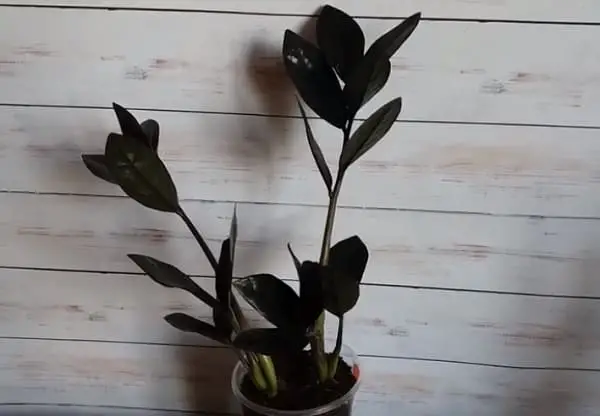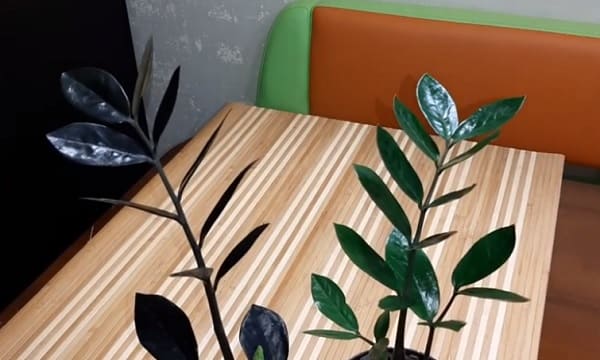Zamiokulkas has been in room culture for a very short time since 1996. A typical dollar tree is usually grown. Breeding new varieties are difficult this is a monotypic genus, so there is simply nothing to cross the flower with.
The appearance of mutated leaves or at least segments that give plants during reproduction that inherit non-standard traits is an unpredictable matter. Nevertheless, there are already several very interesting cultivars, the most famous is Zamioculcas Black raven.

Zamioculcas Raven (Black Raven plant): Description
Zamioculcas Raven has been on sale since 2017, is quite tall – 90-100 cm.
It is still unknown whether he will be able to reach one and a half meters over time. The rhizome is a modified thick underground stem (tuber) with adventitious roots similar to laces.
What in Zamioculcas is usually called stems, in fact, the rachis is the axes of complex odd-pinnate leaves. They are straight, strong, with swollen thick bases there succulents store water in case of drought. Segments are leathery, fleshy, oval with pointed tips and a strong glossy sheen, lacquered to the touch.
The mature leaves of Zamiokulkas Raven are of a very dark green hue, like that of the Black Prince rubber plant. But they don’t immediately become that way. In the first months after the purchase, flower growers may think that they have been sold a plant with tinted leaves.
Young rachis salad. Against the background of old black plates, they seem even lighter than that of ordinary zamiokulkas. When the segments open up and begin to darken, a charcoal strip first appears along the edge, and dots of the same color inside. Gradually the whole sheet becomes black.
Whether the plant is blooming is difficult to say. When caring at home, this is already a rare occurrence, and Zamioculcas Raven Black Crow is a new variety.
Dollar tree sap is poisonous, especially if it enters the digestive tract or mucous membranes. Allergy sufferers and people with delicate skin are advised to wear gloves. Others can do without them. It is enough to wash your hands if they get dirty with Zamioculcas Raven juice.
Many growers complain that when breeding with leaf segments, cats chew the sprouts that have hatched. This rarely happens with adult specimens.
What to do after purchase
At home, the flower must be immediately quarantined. The dollar tree should be separate from other indoor plants so that the owners can spot pests or signs of disease in time.
After 2 weeks, Zamioculcas Raven is taken out of the pot, the root and substrate are examined. If it grew in transport peat, it is recommended to transplant the flower into fresh soil for cacti in spring or early summer. At the end of the season and during the rest period, it is better not to carry out the operation, wait at least until mid-January.
An urgent transplant Raven requires in the following cases:
- the pot has burst;
- the substrate is sour;
- the root rots;
- found soil pests.
Zamioculcas Raven care
Requirements that differ from those with green leaves are few in the black dollar tree, but they are. Basically, this concerns placement and watering.
Temperature and lighting
Unlike green varieties, Zamioculcas Raven with black leaves is more capricious when choosing a place. In the shade, the segments lose their original color, become small, the distance between them increases, and the rachises tend to take a horizontal position. The leaves burn in the bright sun. The lighting should be intense, but not in direct light. Zamioculcas Raven tolerates only light partial shade.
For the leaves to remain black, the plant needs at least 6 hours of ambient light per day.
Zamioculcas Raven is thermophilic, prefers a temperature of 18-25 ° C all year round. In winter, it should not fall below 18 ° C. But the plant tolerates heat worse than other varieties because of black leaves, it is desirable that the thermometer does not rise to 30 ° C.
Zamioculcas Raven Humidity and watering
The main thing when caring for black Zamioculcas Raven is to prevent overflow or stagnation of water in the pot. Excess moisture leads to the decay of leaves and tubers, which is the most common cause of plant death.
Waterlogging is especially dangerous at low temperatures.
Raven should be watered even less frequently than green varieties:
- in spring and summer – no more than every 2 weeks;
- with warm wintering – a maximum of once a month;
- when the temperature is close to 16 ° C and the lighting is clearly insufficient – even less often.
If the owners doubt whether the Black Equal needs watering, it is better to postpone the watering can. The earthen lump should dry from top to bottom.
The flower tolerates dry air well. It can be sprayed only occasionally, in extreme heat, or if in winter the pot is next to heating devices.
To maintain hygiene and beauty, dust from the leaves is removed with a clean, damp cloth.
Fertilization of Zamioculcas Raven
The owners may not expect that regular fertilization will accelerate the growth of the Black Raven. Topdressing of Zamioculcas Raven contributes to an increase in decorativeness and resistance to unfavorable factors, and not to the emergence of the new rachis.
From March to August, fertilizers are used for cacti 1-2 times a month, in autumn and winter the plant should rest. It is better to under-feed the culture, and not give more nutrients than necessary.

Zamioculcas Raven transplant
Black Raven grows slower than other varieties, which means that it should be moved to a new container less often – once every 3-5 years. The owners do the right thing when they transplant when the old pot bursts.
Exceptions:
- soured soil;
- the root rots;
- insects have bred in the soil;
- transfer from transport peat;
- age up to 3 years.
Zamioculcas Raven soil mix
For Zamiokulkas variety Black, ready-made soil for succulents is equal. If there is a lot of peat and few mineral components, it can be improved by adding about 20%:
- coarse sand;
- pumice;
- expanded clay;
- perlite;
- lava;
- crumbs of red brick;
- zeolite;
- small stones.
Charcoal won’t hurt anyway. It filters and absorbs water, serves as an antiseptic, protects against fungal diseases.
The basic requirements for the substrate for Zamioculcas Raven, including the Black variety, is equal to:
- loose structure;
- permeability;
- high aeration;
- low moisture content;
- low nutritional value;
- high content of mineral components;
- neutral or slightly acidic reaction.
Pot for Zamioculcas Raven
The plant needs a tight container of regular shape. It will not grow until it is entwined with roots by an earthen ball. Each next container should be 2-3 cm larger than the previous one.
At the bottom, drainage holes are required for the outflow of water, otherwise moisture can stagnate, which will cause the death of the flower. For the same purpose, a layer of expanded clay is placed on the bottom at least 25% of the volume.
The best material is plastic. Clay pots, firstly, absorb moisture, and secondly, they contain one hole. In order not to spoil the interior, an ugly plastic container can be put in a planter or designer pot of any shape, color, and size.
Transplant process of Zamioculcas Raven
The operation is simple:
- Take the flower out of the container.
- Examine the root, if necessary, the rotten areas are cleaned to healthy tissue.
- Drainage and a thin layer of substrate are poured into the bottom of the new pot.
- Zamioculcas is installed in the center.
- Fill the voids with soil, crush.
- Watered no earlier than a week later.
The rhizome should only be slightly dusted with soil. Some owners generally leave part of the tuber on the surface, but this is wrong.
Zamioculcas Raven propagation
Zamioculcas Raven Black is easy to dilute on its own, which can be considered a great advantage since the flower is expensive. Especially varieties with the original color of the leaves.
Recommended methods:
- Rhizome division during transplantation. The tubers easily move away from each other, they are planted in individual small pots, looked after, like an adult plant. If part of the rhizome has rotted, it is pre-stripped to healthy tissue. Then it is dried until callus is formed.
- The leaves of the black zamiokulkas Raven take root well. The whole plate can be placed in water or immediately placed in a lightweight substrate.
- The culture propagates in pieces of rachis or in segments – they are planted in perlite or clean sand. First, a small tuber forms at the bottom, after 6-12 months the first leaf will appear.
For the operation to be successful, Zamioculcas Raven must be provided with:
- temperature about 25 ° C;
- bright diffused light;
- very moderate watering.
Zamioculcas Raven problems
The plant is rarely affected by pests or diseases. Due to the overflow, the root and rachis can begin to rot, due to the negligence of the owners, scale insects sometimes move to Black from other flowers.
Much more often, Zamioculcas Raven suffers from care errors:
- spots on segments cold, draft, at 14 ° C the plant may die;
- thickening of rachis became soft – overflow;
- the base of the central axis wrinkled – overdry;
- the segments are small, the distance between them has increased, Raven has become not black, but dirty green – lack of light;
- purple spots on elastic, juicy rachis are a feature of the culture;
- only the lower segments on old leaves fall off – a natural process.
